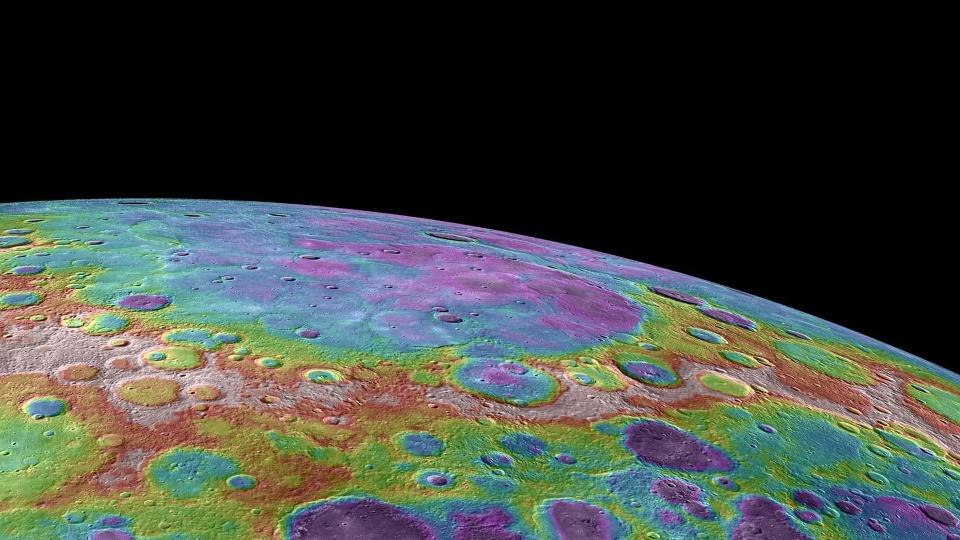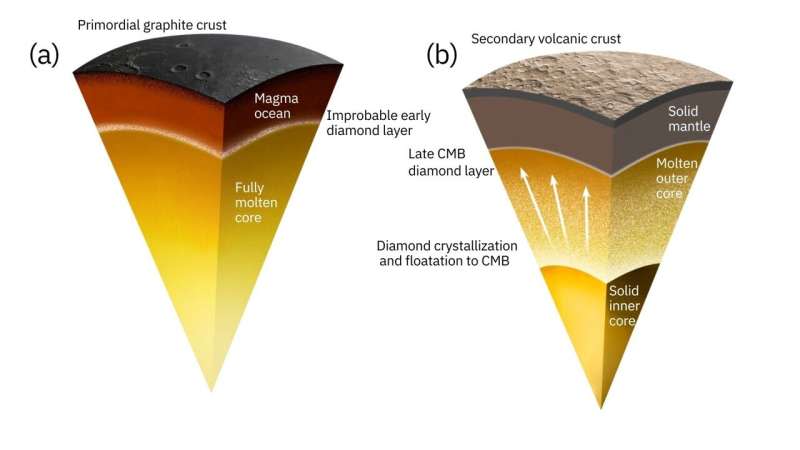9 miles of solid diamonds may lurk beneath Mercury's surface, new study finds
When you buy through links on our articles, Future and its syndication partners may earn a commission.

Mercury may have a thick layer of diamonds hundreds of miles below its surface, a new study shows. The findings, published June 14 in the journal Nature Communications, may help solve mysteries about the planet's composition and peculiar magnetic field.
Mercury is filled with mysteries. For one, it has a magnetic field. Although it's much weaker than Earth's, the magnetism is unexpected because the planet is tiny and appears to be geologically inactive. Mercury also has unusually dark surface patches that NASA's Messenger mission identified as graphite, a form of carbon.
That latter feature is what sparked the curiosity of Yanhao Lin, a staff scientist at the Center for High Pressure Science and Technology Advanced Research in Beijing and co-author of the study. Mercury's extremely high carbon content "made me realize that something special probably happened within its interior," he said in a statement.
Despite Mercury’s oddities, scientists suspect it probably formed the way other terrestrial planets did: from the cooling of a hot magma ocean. In Mercury's case, this ocean was likely rich in carbon and silicate. First, metals coagulated within it, forming a central core, while the remaining magma crystallized into the planet's middle mantle and outer crust.
For years, researchers thought the mantle's temperature and pressure were just high enough for carbon to form graphite, which, being lighter than the mantle, floated to the surface. But a 2019 study suggested that Mercury's mantle may be 80 miles (50 kilometers) deeper than previously thought. That would considerably ramp up the pressure and temperature at the boundary between the core and the mantle, creating conditions where the carbon could crystallize into diamond.
To investigate this possibility, a team of Belgian and Chinese researchers, including Lin, whipped up chemical soups that included iron, silica and carbon. Such mixtures, similar in composition to certain kinds of meteorites, are thought to mimic the infant Mercury's magma ocean. The researchers also swamped these soups with varying amounts of iron sulfide; they figured the magma ocean contained loads of sulfur, as Mercury's present-day surface is also sulfur-rich.
Related: Uranus and Neptune aren't made of what we thought, new study hints
Using a multiple-anvil press, the team subjected the chemical mixtures to crushing pressures of 7 gigapascals — roughly 70,000 times the pressure of Earth's atmosphere at sea level — and temperatures of up to 3,578 degrees Fahrenheit (1,970 degrees Celsius). These extreme conditions simulate those deep within Mercury.
In addition, the researchers used computer models to get more precise measurements of the pressure and temperature at Mercury's core-mantle boundary, besides simulating the physical conditions under which graphite or diamond would be stable. Such computer models, according to Lin, tell us about the fundamental structures of a planet's interior.

The experiments showed that minerals such as olivine likely formed in the mantle — a finding that was consistent with previous studies. However, the team also discovered that adding sulfur to the chemical brew caused it to solidify only at much higher temperatures. Such conditions are more favorable for forming diamonds. Indeed, the team's computer simulations showed that, under these revised conditions, diamonds may have crystallized when Mercury's inner core solidified. Because it was less dense than the core, it then floated up to the core-mantle boundary. The calculations also showed that the diamonds, if present, form a layer with an average thickness of about 9 miles (15 km).
Mining these gems isn't exactly feasible, however. Apart from the planet's extreme temperatures, the diamonds are way too deep — about 300 miles (485 km) below the surface — to be extracted.
RELATED STORIES
—Mercury may have a 'potentially habitable' region below its surface, salty glaciers suggest
—The sun has blasted Mercury with a plasma wave
—Earth's magnetic field formed before the planet's core, study suggests
But the gemstones are important for a different reason: They may be responsible for Mercury's magnetic field. The diamonds may help transfer heat between the core and the mantle, which would create temperature differences and cause liquid iron to swirl, thereby creating a magnetic field, Lin explained.
The results could also help to explain how carbon-rich exoplanets evolve. "The processes that led to the formation of a diamond layer on Mercury might also have occurred on other planets, potentially leaving similar signatures," Lin said.
More clues may come from BepiColombo, a joint mission of the European Space Agency and the Japan Aerospace Exploration Agency. Launched in 2018, the spacecraft is scheduled to begin orbiting Mercury in 2025.

